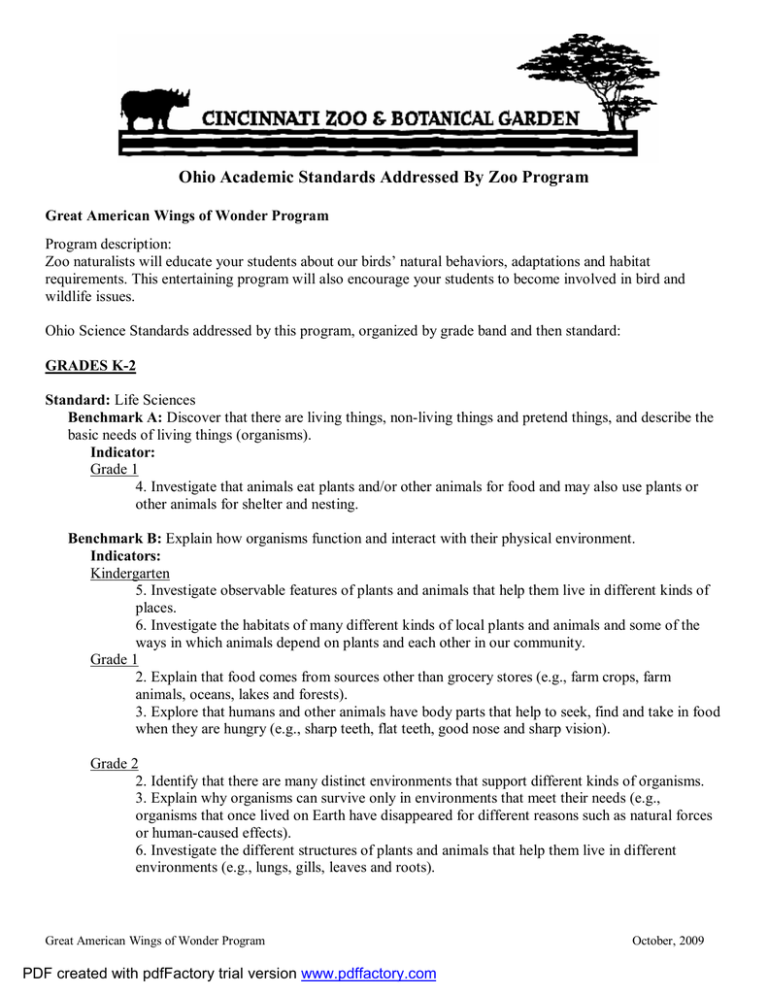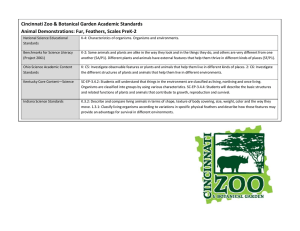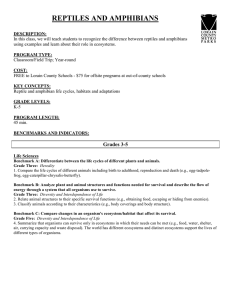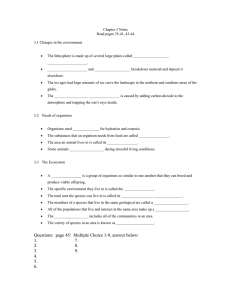Ohio Academic Standards Addressed By Zoo Program
advertisement

Ohio Academic Standards Addressed By Zoo Program Great American Wings of Wonder Program Program description: Zoo naturalists will educate your students about our birds’ natural behaviors, adaptations and habitat requirements. This entertaining program will also encourage your students to become involved in bird and wildlife issues. Ohio Science Standards addressed by this program, organized by grade band and then standard: GRADES K-2 Standard: Life Sciences Benchmark A: Discover that there are living things, non-living things and pretend things, and describe the basic needs of living things (organisms). Indicator: Grade 1 4. Investigate that animals eat plants and/or other animals for food and may also use plants or other animals for shelter and nesting. Benchmark B: Explain how organisms function and interact with their physical environment. Indicators: Kindergarten 5. Investigate observable features of plants and animals that help them live in different kinds of places. 6. Investigate the habitats of many different kinds of local plants and animals and some of the ways in which animals depend on plants and each other in our community. Grade 1 2. Explain that food comes from sources other than grocery stores (e.g., farm crops, farm animals, oceans, lakes and forests). 3. Explore that humans and other animals have body parts that help to seek, find and take in food when they are hungry (e.g., sharp teeth, flat teeth, good nose and sharp vision). Grade 2 2. Identify that there are many distinct environments that support different kinds of organisms. 3. Explain why organisms can survive only in environments that meet their needs (e.g., organisms that once lived on Earth have disappeared for different reasons such as natural forces or human-caused effects). 6. Investigate the different structures of plants and animals that help them live in different environments (e.g., lungs, gills, leaves and roots). Great American Wings of Wonder Program PDF created with pdfFactory trial version www.pdffactory.com October, 2009 Standard: Scientific Ways of Knowing Benchmark B: Recognize the importance of respect for all living things. Indicator: Kindergarten 3. Interact with living things and the environment in ways that promote respect. ---------------------------------------------------------------------------------------------------------------------------GRADES 3-5 Standard: Life Sciences Benchmark B: Analyze plant and animal structures and functions needed for survival and describe the flow of energy through a system that all organisms use to survive. Indicators: Grade 3 2. Relate animal structures to their specific survival functions (e.g., obtaining food, escaping or hiding from enemies). 3. Classify animals according to their characteristics (e.g., body coverings and body structure). Benchmark C: Compare changes in an organism’s ecosystem/habitat that affect its survival. Grade 3 4. Use examples to explain that extinct organisms may resemble organisms that are alive today. 6. Describe how changes in an organism’s habitat are sometimes beneficial and sometimes harmful. Grade 5 4. Summarize that organisms can survive only in ecosystems in which their needs can be met (e.g., food, water, shelter, air carrying capacity and waste disposal). The world has different ecosystems and distinct ecosystems support the lives of different types of organisms. 6. Analyze how all organisms, including humans, cause changes in their ecosystems and how these changes can be beneficial, neutral or detrimental (e.g., beaver ponds, earthworm burrows, grasshoppers eating plants, people planting and cutting trees and people introducing a new species). ---------------------------------------------------------------------------------------------------------------------------GRADES 6-8 Standard: Life Sciences Benchmark A: Explain that the basic functions of organisms are carried out in cells and groups of specialized cells form tissues and organs; the combination of these cells make up multicellular organisms that have a variety of body plans and internal structures. Indicator: Grade 7 1. Investigate the great variety of body plans and internal structures found in multicellular organisms. Benchmark B: Describe the characteristics of an organism in terms of a combination of inherited traits and recognize reproduction as a characteristic of living organisms essential to the continuation of the species. Indicators: Grade 7 8. Investigate the great diversity among organisms. Great American Wings of Wonder Program PDF created with pdfFactory trial version www.pdffactory.com October, 2009 Grade 8 3. Explain how variations in structure, behavior or physiology allow some organisms to enhance their reproductive success and survival in a particular environment. Benchmark C: Explain how energy entering the ecosystems as sunlight supports the life of organisms through photosynthesis and the transfer of energy through the interactions of organisms and the environment. Indicators: Grade 6 8. Describe how organisms may interact with one another. Grade 7 2. Investigate how organisms or populations may interact with one another through symbiotic relationships and how some species have become so adapted to each other that neither could survive without the other (e.g., predator-prey, parasitism, mutualism and commensalism). 3. Explain how the number of organisms an ecosystem can support depends on adequate biotic (living) resource (e.g., plants, animals) and abiotic (non-living) resources (e.g., light, water and soil). Benchmark D: Explain how extinction of a species occurs when the environment changes and its adaptive characteristics are insufficient to allow survival (as seen in evidence of the fossil record). Indicator: Grade 7 4. Investigate how overpopulation impacts an ecosystem. ---------------------------------------------------------------------------------------------------------------------------Grades 9-10 Standard: Earth and Space Sciences Benchmark D: Describe the finite nature of Earth’s resources and those human activities that can conserve or deplete Earth’s resources. Indicator: Grade 10 5. Explain how the acquisition and use of resources, urban growth and waste disposal can accelerate natural change and impact the quality of life. Standard: Life Sciences Benchmark E: Explain how evolutionary relationships contribute to an understanding of the unity and diversity of life. Indicator: Grade 10 14. Relate diversity and adaptation to structures and their functions in living organisms (e.g., adaptive radiation). Benchmark F: Indicator: Grade 10 15. Explain how living things interact with biotic and abiotic components of the environment (e.g., predation, competition, natural disasters and weather). Great American Wings of Wonder Program PDF created with pdfFactory trial version www.pdffactory.com October, 2009 Benchmark G: Describe how human activities can impact the status of natural systems. Indicators: Grade 10 18. Describe ways that human activities can deliberately or inadvertently alter the equilibrium in ecosystems. Explain how changes in technology/biotechnology can cause significant changes, either positive or negative, in environmental quality and carrying capacity. 19. Illustrate how uses of resources at local, state, regional, national, and global levels have affected the quality of life (e.g., energy, production and sustainable vs. nonsustainable agriculture). ---------------------------------------------------------------------------------------------------------------------------GRADES 11-12 Standard: Earth and Space Sciences Benchmark C: Explain that humans are an integral part of the Earth’s system and the choices humans make today impact natural systems in the future. Indicator: Grade 11 12. Explain ways in which humans have had a major effect on other species (e.g., the influence of humans on other organisms occurs through land use, which decreases space available to other species and pollution, which changes the chemical composition of air, soil and water. Standard: Life Sciences Benchmark B: Explain how humans are connected to and impact natural systems. Indicator: Grade 11 5. Investigate the impact on the structure and stability of ecosystems due to changes in their biotic and abiotic components as a result of human activity. Benchmark E: Explain the interconnectedness of the components of a natural system. Indicator: Grade 11 6. Predict some possible impacts on an ecosystem with the introduction of a non-native species. Great American Wings of Wonder Program PDF created with pdfFactory trial version www.pdffactory.com October, 2009






